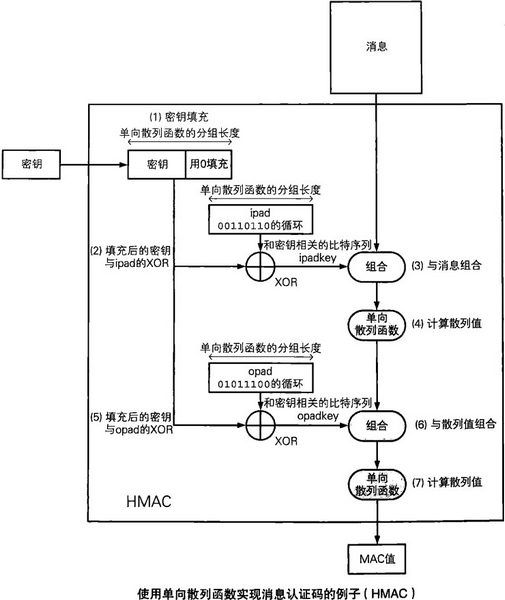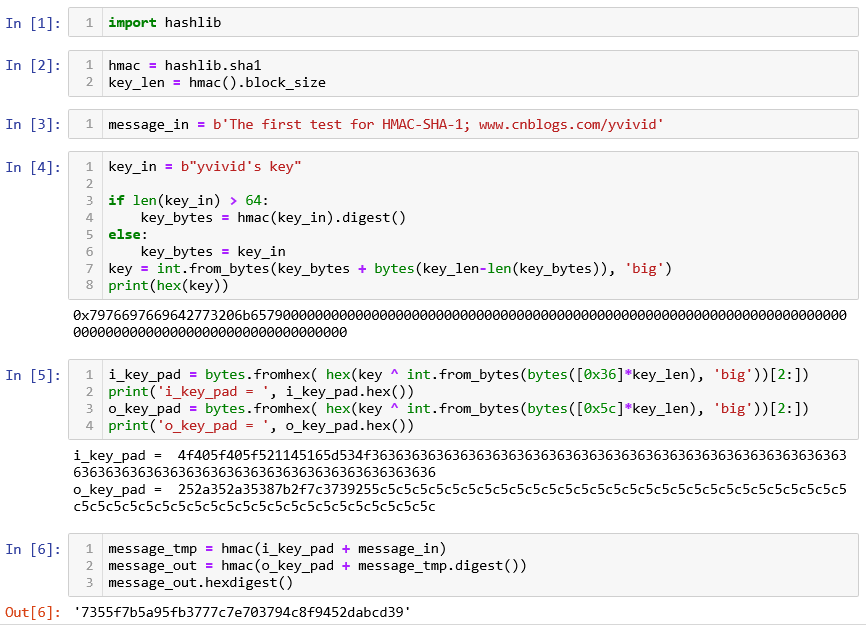1, HMAC concept
HMAC (Hash-based Message Authentication Code) hash-based message authentication code, a secure communication is a necessary component parts.
Message is to prevent tampering, and with symmetric encryption to protect the integrity of data communication.
Reference HMAC implementation specification, Hash algorithm may be md5, sha1, sha-2 (sha256, sha385, sha512) and the like;
Without considering the specific implementation of hash algorithm, its implementation method is as follows:

1) Key filling :
If the key is longer than the packet length Hash function (the block_size), then use the Hash function to obtain a hash key value, this hash value is then used as an HMAC key.
If the key of length shorter score, 0 is filled in the end, until it reaches the length of the packet length of a one-way hash function.
Note: the length of a hash value digest_size usually shorter than the block_size packet length, and therefore, in fact, longer than the length of the packet after the hash value is calculated, there remains a need to fill in the tail 0.
2) key with XOR ipad after filling the filled keys, and the bit sequence XOR operation is referred to as the ipad.
00110110 ipad is the bit sequence (i.e., hex 36) continuous cycle packet length bit sequence is repeated until formed. Wherein: ipad i is the inner meaning.
The value obtained by an XOR operation, and a packet length is the same one-way hash function, and the key and the associated bit sequence. Here we will become the bit sequence ipadkey.
3) in conjunction with the message to the message combining ipadkey, i.e. the bit sequence and the associated keys (ipadkey) appended to the beginning of the message .
4)计算散列值 将步骤3的结果输入单向散列函数,并计算出散列值。
5)填充后的密钥与opad的XOR 将填充后的密钥与被称为opad的比特序列进行XOR运算。
opad是将01011100这一比特序列(即十六进制5C)不断循环反复直到达到分组长度所形成的比特序列,其中opad的o是outer的意思。
XOR运算所得到的结果也是一个和单向散列函数的分组长度相同,且和密钥相关的比特序列。这里我们将这个比特序列称为opadkey。
6)与散列值组合 opadkey附加在步骤4的散列值前面。
7)计算散列值 将步骤6的结果输入单向散列函数,并计算出散列值。这个值就是最终的MAC值。
2、HMAC Python hmac库实现
在 Python 中, 直接提供了 hmac 库实现相关操作。
如下所示,是yvivid基于 hmac库的一个实现。

更多hmac库的使用,请参考 python doc。
3、HMAC 的 笨办法( 仅利用Python hashlib库实现)
基于HMAC的原理,是否可以在已有 hash算法上,自己实现 HMAC算法。
下面是 yvivid 在 Python上,基于 hashlib库(hash算法)的基础上,HMAC自行编码的一个实现的。

1)由于 需要 XOR是实现,因此 使用了 int 和 bytes的转换,写的不是很简洁(逻辑电路的思维)。
2) i_key_pad 和 o_key_pad 实际上展开到 block_size长度了。
注:其实 在自己实现时,还没注意到 python的 hmac 库,结果是自己摸索 和 openssl输出进行对比分析的。
大家可自己分析 Python36\Lib\hmac.py 的代码。部分处理比我写的简洁,使用了 bytes的 ljust,translate特性。
但只有自己实现 才能感觉到其真实的原理。
4、易混淆的概念
1)填充阶段,尤其是 分组长度block_size 和 摘要(散列值)长度digest_size,
描述的概念比较混淆,导致编写代码过程走了弯路。
分组长度block_size 是 Hash 处理输入数据时,是按照 block_size大小来分块(block)处理的。
摘要(散列值)长度digest_size 是 Hash完成后,输出的 摘要(散列值)字节长度。
2)XOR 阶段,yvivid的实现采用了并行的思路,基于整数 的异或操作(python语法的 ^)。
3)Python 语法方面,对于 bytes 还是不熟悉,需要进一步学习。
附录:常用散列算法的分组长度和摘要长度。
| 单向散列函数 | 分组长度 block_size | 摘要长度digest_size |
| MD5 | 64 Bytes (512bit) | 16 Bytes (128bit) |
| SHA1 | 64 Bytes (512bit) | 20 Bytes (160bit) |
| SHA256 | 64 Bytes (512bit) | 32 Bytes (256bit) |
| SHA512 | 128 Bytes (1024bit) | 64 Bytes (512bit) |
原创声明:
HMAC原理是公共的,但 python代码实现(尤其是 基于hashlib下 自己的编写),是基于本人在 python 实现,转载请声明出处。
https://www.cnblogs.com/yvivid/p/hmac_basic.html
参考文献:
1) 图解密码技术(第3版) ,[日]结城浩;
学习笔记:http://flamepeak.com/2016/11/23/tu-jie-mi-ma-ji-shu-authentication20161123/
2) Python 3.6.8 documentation / Library Reference
hashlib — Secure hashes and message digests
hmac — Keyed-Hashing for Message Authentication